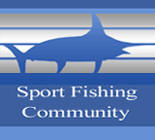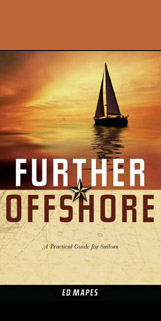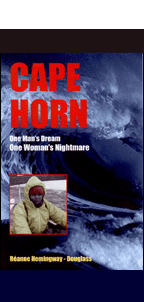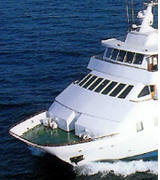|
appearing in the August 1982 issue of Sail Magazine.
To me, hove-to means your boat is no
longer sailing forward. It is stopped and making leeway with its bow
about fifty degrees from the wind. The most erroneous statement I have
read about heaving-to is, "Simply back the staysail and set a reefed
main." This method does work on some boats in some conditions. But in
strong winds with heavy seas, the bow of most boats is forced off by the
backed staysail, and the boat usually ends up slowly sailing along the
trough of the waves. If the boat is making headway, in my opinion, you
are not hove-to, you are sailing!
Since all sailplans have different
fore-and-aft balance and all hulls have a different center of lateral
resistance, you must experiment with your boat to find out how to hold
its bow into the wind. Practicing in moderate to heavy winds and seas
will give you an educated guess about what to expect in stronger storm
conditions. Lin and I have lain hove-to quite happily in our 24-foot
cutter, Seraffyn, with reefed mainsail only. Two of the ketches we
delivered lay hove-to in Force 10 winds (48-55 knots) with just their
mizzens sheeted in flat. Some fin-keel-and-skeg boats heave-to with a
storm jib on the backstay; others are happy with a storm trysail set;
still others need a sea anchor or drogue to hold their bow up near the
wind. Experimenting teaches you more about your hull and sail balance
and will make your voyaging safer, more comfortable, and therefore more
enjoyable.
Heaving-to in light to medium winds (up to
25 knots) is easily done by trimming your rudder and sails so your boat
is headed into the wind and sea as though you were close hauled.
Seraffyn heaves-to with a full mainsail and the helm tied to leeward
about ten or fifteen degrees. In the gusts, the mainsail luffs a bit but
still does not have enough power to tack the boat through the wind. This
is the stall point you want to achieve to heave-to correctly. In light
to medium winds it is not vital to have the bow of the boat headed close
to the wind, but you motion through the water should be stopped.
Preventing this forward motion becomes very important when you are
hove-to in breaking seas, however. A boat with a long keel and
moderately cutaway forefoot would probably be able to heave-to the same
way. Tie the tiller so the boat will stall before it tacks. Some
fin-keel-and-skeg sloops are so lively that they will tack in the
lightest winds if you keep the full mainsail up alone. To combat this
tendency, try reefing the main and adjusting the helm more amidships or
backing a staysail or small jib.
No matter what type of boat you are trying
to heave-to, be sure to adjust your tiller at least a bit to leeward. If
the tiller is tied to weather at all, an increase in wind strength could
bear the boat off and cause her to gybe accidentally. Tie your tiller
with heavy shockcord so the cord absorbs some of the stress that would
otherwise be exerted on the rudder assembly. Furthermore, for long-term
cruising safety, have rudder stops.
Heaving-to in heavy winds (gale to storm
force) when the seas start to build differs from heaving-to in moderate
winds; in these conditions you want to use the wake or slick of your
boat to confuse the breaking seas. The key to heaving-to in these
conditions is to get your boat to drift dead downwind. In this way you
stay directly behind your amazingly protective slick. We lay hove-to in
Seraffyn 400 miles east of England for thirty hours in a full force 10
storm (50-55 knots of wind). Storm-force winds were reported in all
European sea areas from Iceland to northern Spain. By the second day the
waves had built to long over-hanging crests, which were breaking
dangerously on either side of our slick. Yet in the afternoon our
foredeck was only damp from spray and the side decks had actually dried
off in the September sun. No green seas had broken against our hull.
Occasionally broken-down white foam would skid across the slick to slap
ineffectively against the bow. We'd lost only twenty miles of the
weathering we'd worked for two weeks to gain. I think this particular
incident convinced Lin and me that as long as we had searoom and we
chose our sailing seasons carefully, we could weather almost any storm.
When things did get rough, we could simply heave-to and feel as though
we'd pulled over to the side of the road and parked.
Figure 1 shows how generally to hold a
boat hove-to in those storm-generated seas. Your boat may require
different sail or helm adjustments from the four illustrated. The most
important factor is to make sure your boat is stopped and drifting
down-wind behind its slick. If you find you are forereaching, try tying
the tiller more to leeward. The force of the wave action on the angled
rudder pushes the stern of your boat down and the bow up. That is why
tying the tiller to leeward helps stop the forward motion of your boat.
In the same wind and sea conditions, a fin-keel-and-skeg sloop might
need a backstaysail. If this doesn't work, try a drogue or parachute sea
anchor in conjunction with a backstaysail to keep your boat behind its
slick.
Once we have any boat we are on properly
hove-to, we usually hit the bunk. If we are in a fog or concerned about
ships we leave a strobe light flashing at the masthead. One of us goes
on deck every hour to check for chafe on any storm gear and the set of
the riding sail. But most important, we watch to see if the boat is
forereaching. If your boat moves forward from behind your slick, a large
sea could break onto your bow. To be sure we are not forereaching I drop
a couple of paper towels into our slick. If the boat is staying directly
to leeward of the slick, the paper towels will drift dead up wind. If
the towels end up farther and farther aft of the boat, it means the boat
is sailing out of its protection. You can see these white pieces of
paper quite easily at night with a flashlight.
If your boat is determined to forereach,
you should set a sea anchor of some sort. Although there are a variety
of sea anchors available, we prefer a parachute anchor. This large
diameter drogue will definitely stop any forward motion so you drift
directly behind your protective slick.
We used a para-anchor with a triple-reefed
mainsail on Seraffyn in the Gulf of Papagayo off Mexico and in the North
Pacific during storms with winds reported to range from strong gale
force to hurricane force (between 40 and 70 knots). Our nine-foot
diameter, coarsely woven nylon para-anchor is much stronger and easier
to stow than the smaller diameter, traditional, iron-hooped,
canvas-coned sea anchors described in older cruising books. The nylon
para-anchor used with a nylon rode is more elastic than its canvas and
manila counterpart, and the nylon rode absorbs the shock of the boat
surging against the sea anchor. This gear helps a vessel lie hove-to
safely fifty degrees off the wind even after the winds increase beyond
storm force. Our para-anchor is a surplus Navy cargo chute. They are
used extensively for this purpose by the fishing fleet around southern
California and Mexico. One supply source is Gerrard Fiorentino Marine
Sales, 311 22nd Street, San Pedro, CA, which has twenty-four-hour
service. The parachute-type sea anchors come in nine-, sixteen-,
twenty-four-, and twenty-eight-foot diameters..
The first time we hove-to with a para-anchor
and triple-reefed mainsail, Seraffyn lay almost head-to-wind in the
manner described in the book, The Venturesome Voyage of Captain Voss. We
were continually woken up when the mainsail luffed violently as the para-anchor
jerked us head to wind. The action was hard on the sail and on our
nerves.
We later figured out how to lie in a
close-hauled position even with the para-anchor set. Our keel then
provided the slick to break down the seas so they would have less force
on our hull, ruder, and the para-anchor gear. We rigged an adjustable
fairlead as shown in Figure 2, using gear we already had on board. This
fairlead let us control the direction of the para-anchor strains in
relation to the direction of the wind. Now we could lie fifty degrees
off the wind. If any wave did sneak into our slick area, its force would
first be exerted on the boat's bow. The bow would fall off to leeward,
stretching and tugging on the nylon rode and para-anchor. They would
absorb most of the shock, so the rudder received little strain.
This position also has another advantage.
You are now presenting the corners of your cabins and hatches to the
force of the sea, and these corners are much stronger than the flat side
or front of your cabin. Some people have hove-to stern to the wind and
sea. This position is less safe because your relatively weak cockpit,
sliding hatch, and companionway doors or dropboards are then vulnerable
to a breaking sea.
Once you are lying to the para-anchor, you
must adjust the length of the rode so the boat and anchor crest their
individual waves at the same time. If the boat crests one wave while the
para-anchor is in the trough of another, the differences in the wave
action will cause an uncomfortable, gear straining jerk.
One of the most important uses of a para-anchor
is to cut your rate of drift. A boat running toward a lee shore, even if
it is trailing warps, loses valuable searoom at the rate of 3 knots or
more. A boat lying hove-to drifts to leeward about one nautical mile in
an hour, possibly less.
The first time I set our para-anchor, I
used the trip line and attached a long line from it all the way back to
the boat. The para-anchor twisted on its connecting swivel and wound up
the trip line and anchor like spaghetti. After this experience, we
eliminated the whole trip line. Although retrieving the sea anchor took
longer without the trip line, it was still not too difficult. When it
was safe to get underway again, we used our anchor windlass to grind in
the rode. As the boat and para-anchor lay in the trough of their waves,
it was quite easy to winch in six or eight feet of line. As the boat
reached the crest of the wave, the line tension increased, so we'd hold
on and wait for the next trough. When the para-anchor was next to the
bow, we hooked it with a boathook and pulled it on board.
Setting the para-anchor was even easier
than retrieving it. We laid it out on the foredeck to make sure none o
fits lines were tangled, shackled the second anchor bower (a
300-foot-long, 5/8-inch, three-strand nylon line) to the 3/8-inch
galvanized swivel and then fed the para-anchor, cover first, slowly over
the bow. I eased out the line as the boat drifted slowly downwind. As
soon as the rode was snubbed, the para-anchor filled and started
working. It did not need any weights and it always opened as soon as the
strains came on it.
A question we are frequently asked is: How
do you know when it is time to stop and heave-to? When we are beating,
the decision is usually made for us. Waves start breaking against the
weather bow and progress becomes extremely uncomfortable. Most cruising
folks stop going to windward about this same time, but racers frequently
press on.
To heave-to from a beating position,
simply drop your headsail and adjust the sails and helm to hold your
boat in the close-hauled position while drifting dead downwind. Once the
boat is lying comfortably, I like to set up the main topping lift to
take some of the strain off the leech of the reefed sail.
Choosing when it is time to heave-to is
more difficult when you are running. We usually don't like to heave-to
then because we are making great time towards our goal. Running with the
wind and seas also gives us a false sense of security. The decks are
quite often dry, the waves are not slamming against the hull, and the
motion is usually more comfortable. So our rule is, heave-to before the
seas start to crest. It is often hard to judge, but you'll realize it's
time to heave-to when a sea breaks right under your stern and the boat
is given an uneasy push. In other words, the power of the seas is
starting to control the boat's normal progress through the water. Do not
confuse this situation with ordinary surfing or acceleration down the
face of a wave. If the boat is steering well, surfing is great fun. But
as the seas get larger and more overhanging, your chances of broaching
are increased. Remember, the decision about when it is time to heave-to
depends completely on the shape of the waves, not the speed of the wind.
Theoretically, you could run under bare poles in winds of 100 knots if
the sea were flat. On the other hand, in a rough situation such as that
often found in the relatively shallow waters of the English Channel
where wind opposes tide and creates steep, breaking seas, running in
Force 7 winds (28-33 knots) could be dangerous. So the classic rule is,
heave-to as soon as you think about it. A falling barometer, wind
clouds, and tired crew will confirm your decision to heave-to early.
When you do decide to stop running, drop
your headsail, sheet in your reefed mainsail, mizzen, or trysail and
round quite quickly into the wind. You'll probably take a good bit of
spray on board as you round through the beam-reaching position. The boat
will heel sharply, but there is no danger if you decide to heave-to
before breaking waves make the boat feel uneasy.
Once you are hove-to and have the boat
settled down, study the size and power of the breaking waves. When you
are lying hove-to, it is a real temptation to start sailing before it is
safe. You seem too comfortable, thanks to the calming affect of your
slick and the relaxed feel of your boat now that it is no longer
thrusting through the water. So you are sometimes lulled into a false
sense of security. Be certain that the waves have decreased in size and
power before you start sailing again. It is my firm belief that heaving-to has become an unused art because most modern yacht designs are for racer/cruiser-type hulls, which are not usually as stable as older, long keeled boats. Added to this is the fact that many of those older boats were gaff-rigged. Their sailplans did not move foreward when they were reefed like sailplans do on modern marconi rigs. This sail area well aft helped hold their bow up into the wind, and the long keels held them steady so they hove-to quietly and easily. There was no fussing with backstaysails, drogues, or sea anchors; they just dropped the jib and sheeted in the mainsail and relaxed.
Also, the older generation of sailors
worked all year round. Fishing boats hove-to while the pulled their
nets, pilot cutters hove-to and waited for ships, square-riggers hove-to
to wait for the fog to clear before they closed the land. Weather was no
deterrent. Those working sailors had to be out there. Today's yachtsmen
who are sailing for pleasure can organize their races or holiday cruises
to coincide with most favorable weather and wind conditions. So can
those yachtsmen who sail the world west about with the prevailing winds.
These people can choose to sail. But even with the best of planning, there will be times when you need to know how to heave-to. Although boats have changed, sailors have not. They still get tired and need rest. Modern boats can be made to heave-to, but since they don't balance the same as their working ancestors, try experimenting with backstaysails, sheeted-in mizzens, trysails, and para-anchors so you can take advantage of the sailors safety valve.
|
|
















